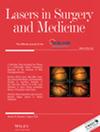Laser NIR Irradiation Enhances Antimicrobial Photodynamic Inactivation of Biofilms of Staphylococcus aureus
Abstract
Objectives
Photodynamic inactivation (PDI) is a powerful technique for eradicating microorganisms, and our group previously demonstrated its effectiveness against planktonic cultures of Staphylococcus aureus bacteria using 5,10,15,20-tetrakis[4-(3-N,N-dimethylaminopropoxy)phenyl]porphyrin (TAPP) and visible light irradiation. However, biofilms exhibit a lower sensitivity to PDI, mainly due to limited penetration of the photosensitizer (PS). In the context of emerging antibacterial strategies, near-infrared treatments (NIRTs) have shown promise, especially for combating resistant strains. NIRT can act either through photon absorption by water, causing a thermal effect on bacteria, or by specific chromophores without a significant temperature increase. Our objective was to enhance biofilm sensitivity to TAPP-PDI by pretreatment with NIRT. This combined approach aims to disrupt biofilms and increase the efficacy of TAPP-PDI against bacterial biofilms.
Materials and Methods
In vitro biofilm models of S. aureus RN6390 were utilized. NIRTs involved a 980 nm laser (continuous mode, 7.5 W/cm2, 30 s, totaling 225 J/cm2) post-TAPP exposure to enhance photosensitizer accumulation. Subsequent visible light irradiation at 180 J/cm2 was employed to perform PDI. Colony-forming unit counts evaluated the synergistic effect on bacterial viability. Scanning electron microscopy visualized the architectural changes in the biofilm structure. TAPP was extracted from bacteria to estimate the impact of NIRT on biofilm penetration.
Results
Using in vitro biofilm models, NIRT application following biofilm exposure to TAPP increased PS accumulation per bacteria. Under these conditions, NIRT induced a transient increase in the temperature of PBS to 46.0 ± 2.6°C (ΔT = 21.5°C). Following exposure to visible light, a synergistic effect emerged, yielding a substantial 4.4 ± 0.1-log CFU reduction. In contrast, the PDI and NIRT treatments individually caused a decrease in viability of 0.9 ± 0.1 and 0.8 ± 0.2-log respectively. Interestingly, preheating TAPP-PBS to 46°C had no significant impact on TAPP-PDI efficacy, suggesting the involvement of thermal and nonthermal effects of NIR action. In addition to the enhanced TAPP penetration, NIRT dispersed the biofilms and induced clefts in the biofilm matrix.
Conclusion
Our findings suggest that NIR irradiation serves as a complementary treatment to PDI. This combined strategy reduces bacterial numbers at lower PS concentrations than standalone PDI treatment, highlighting its potential as an effective and resource-efficient antibacterial approach.

 求助内容:
求助内容: 应助结果提醒方式:
应助结果提醒方式:


